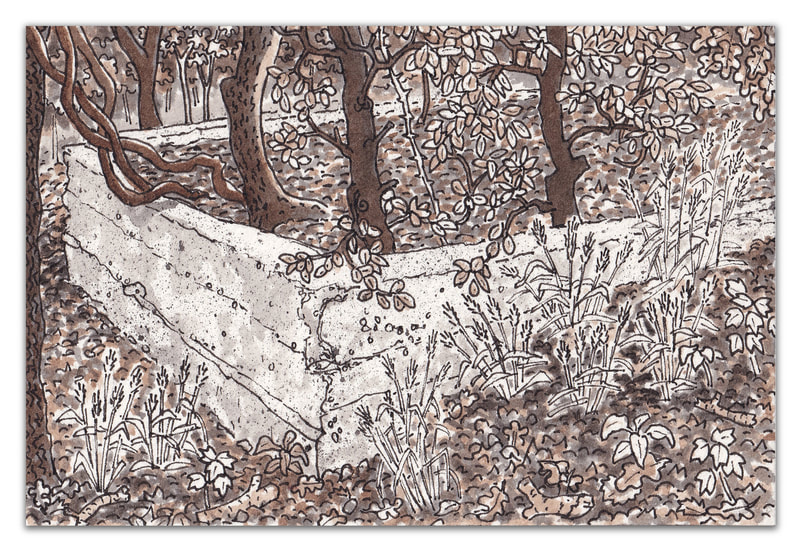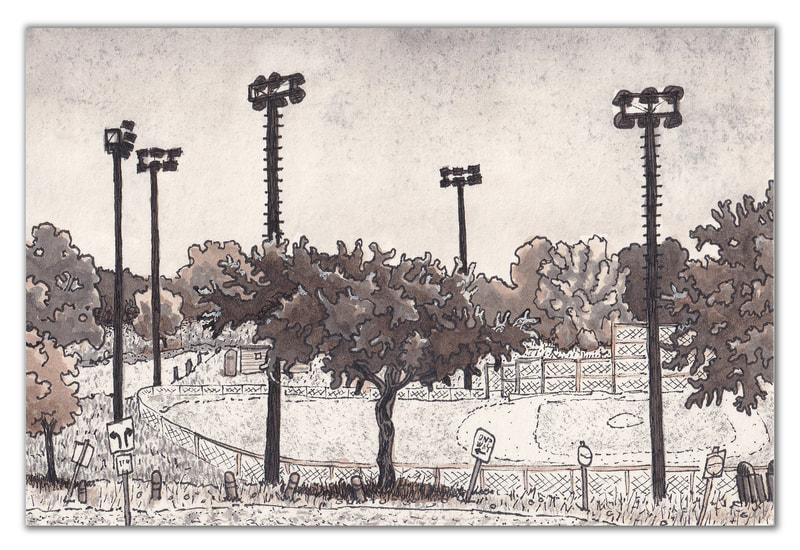|
February 2021
Ro2 Art | Dallas, TX Artist Statement About the Artist |
Ro2 Art is proud to present Embedded Histories – Short & Long, a solo exhibition featuring new works by artist Brad Ford Smith. The show will run from March 13 through April 10, 2021. The exhibition will open with an artist reception at Ro2 Art in the The Cedars located at 1501 S Ervay St, Dallas, TX and will take place from 12-5pm. Embedded Histories – Short & Long is a solo exhibition by artist Brad Ford Smith. Each work is made en plein air, capturing seemingly idyllic landscapes around the city of Dallas, Texas. The artist contrasts these present day scenes with references to forgotten moments in history occurring on those same sites. Through these sometimes jarring juxtapositions, the artist questions how collective memory shapes local identity. Each ink rendering of a sidewalk or a train trestle holds layers of history just beneath the surface. The artist activates the past in this way to discover truths about the city he calls home. Over the last three years my artwork has shifted away from the tongue and cheek, pseudo-science of the Nomadic Fungi Institute to a stripped-down investigation of the city I live in. This shift was not a deliberate, intellectual decision on my part, but rather an attempt to disperse personal chaos generated by the collapse of accountable news sources, the expanding echo chambers of conspiracies, the growing support of anti-science and the selected blindness of history. It became critical to me to not add more disinformation into the world. I found myself asking a basic question: What the hell is true? Where do I find certainty? The simple answer was to look under my own feet at the physical ground I stand on. This piece of earth I know to be solid and true. It is my home. But take a step and ask again. What is this piece of earth? And what about the next step? It didn’t take long to discover just outside my door were deep layers of embedded history. In order to concentrate on the history and the physical experience of creating onsite, I reduced my art medium to the simplest of drawing materials: pen, brush, ink, 4” x 6” watercolor paper and a folding camp chair. With these tools stowed away in my backpack, I can access places near and far where the division between history and time run thin. These thin spots at first were hard to find. There is a lot of hype in our community that I had plow through before finding these thin places. But eventually the surface debris pushed away, and a baseball field becomes a POW camp; a corner lamppost becomes a lynching post; a golf course becomes a thriving Caddo village; an abandoned swimming pool becomes the Fort that helped push the native people out of Texas. On Sunday, January 10th I sat across from three resting bulldozers. Between us are the scattered piles of logs that once composed a railroad trestle that successfully spanned the Trinity river for 125 years. While drawing I connect with what was, is now, and will no longer be. The freshly splintered wood perfumes the air with creosote and old growth pine sap. Then the wind turns, and the pungent diesel fumes fill my nose and sting my eyes. I try to work from an unbiased viewpoint that is not influenced by politics, religion or ethnicity. Focusing on the history that drew me to that place and the experience of being in a place of history. If a Freedmen’s town is now a dilapidated, East Dallas shopping complex, or a grassy field in the Trinity River bottoms is the first place “Elvis has left the building” was announced, these are facts, overlooked/forgotten/swept under the rug history. It is the embedded history that I am there to connect with, and by doing so, these locations are transformed into personal icons of who we have become. Brad Ford Smithis a visual artist and art conservator living in Dallas. Over the years, his curiosity and love of circuitous wanderings have inspired him to explore a variety of topics, from the influence of dyslexia on sight perception, to tongue and cheek pseudo-science experiments under the guise of the Nomadic Fungi Institute. In 2019, as a reaction to the barrage of calamitous news events overwhelming the headlines, Brad’s focus shifted, discarding frivolity in order to explore the truths of his hometown in an attempt to better understand its place in history. |
Ro2 Art Gallery |(214) 406-8819| 2606 Bataan St., Dallas, Texas 75212
Gallery Hours: Tuesday - Saturday, 12 - 5 PM
Browse Catalogue on Artsy
Gallery Hours: Tuesday - Saturday, 12 - 5 PM
Browse Catalogue on Artsy





